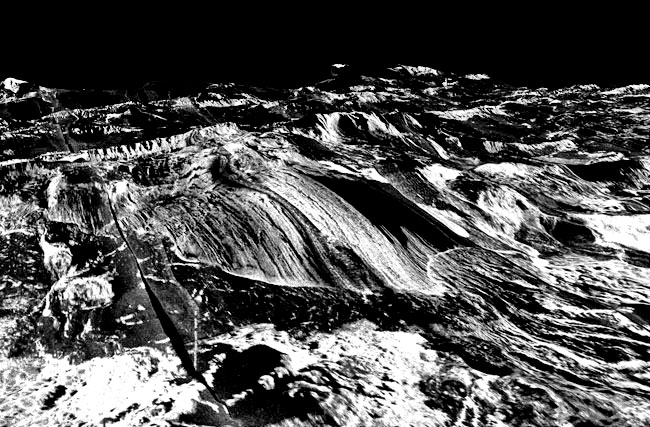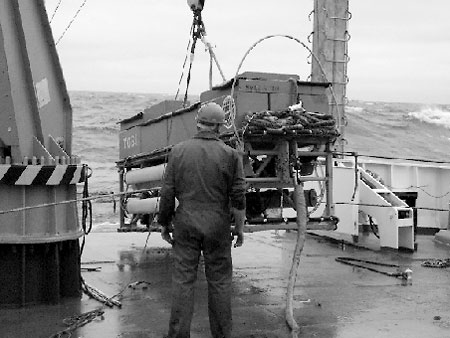|
by Dr.
Rory Howlett from EurekAlert Website
Long-term variations in volcanism help
explain the birth, evolution and death of striking geological
features called oceanic core complexes on the ocean floor, says
geologist Dr
Bramley Murton of the
National Oceanography Centre, Southampton.
Uplifting during their formation causes exposure of lower crust and mantle rocks on the seafloor.
TOBI sidescan sonar imagery draped over multibeam bathymetry provides a unique 3-D view of an active oceanic core complex at 13°19'N, the Mid-Atlantic Ridge. The core complex is the smooth, striated dome forming the left-hand side of the image. To its right is the hummocky neovolcanic zone where recent volcanoes erupt lavas forming the the new oceanic crust. The field of view is around 30km wide. Credit: NOCS
Murton was member of a scientific team that in 2007 sailed to the mid Atlantic Ridge aboard the royal research ship RRS James Cook to study the Earth's crust below the ocean.
Using the deep-towed vehicle TOBI equipped with sophisticated sonar equipment for profiling the deep seafloor, Murton and his colleagues discovered three domed and corrugated massifs, from which they dredged and drilled rock samples.
It turns out that there is indeed a close link between core complex formation and long-term variations in magma supply.
Faults that initiate core complex
formation start off pretty much like normal faults around them. But
in the absence of sufficient magma, the two sides of the fault
continue to slip, and this slippage is further lubricated by
seawater penetration and talc formation along the fault zones,
leading to deep and large off-set faulting.
The study was funded by the UK's Natural
Environment Research Council.
The National Oceanography Centre, Southampton is the UK's focus for ocean science. It is one of the world's leading institutions devoted to research, teaching and technology development in ocean and earth science.
Over 500 research
scientists, lecturing, support and seagoing staff are based at the
centre's purpose-built waterside campus in Southampton along with
over 700 undergraduate and postgraduate students.
The NERC royal research ships RRS James
Cook and RRS Discovery are based at NOCS as is the National Marine
Equipment Pool which includes Autosub and Isis, two of the world's
deepest diving research vehicles.
|


